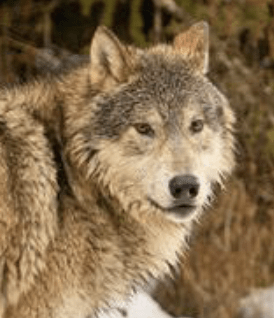Between September 20 and 26, the California Department of Fish and Wildlife (CDFW) received three separate reports of a gray wolf with a purple collar in northern Ventura County. CDFW staff began site inspections and have confirmed recent wolf tracks in the vicinity.
Though CDFW does not have forensic evidence to confirm this at this time, the wolf could be OR-93. The recent reports match the description of OR-93, who was fitted with a purple tracking collar by the U.S. Fish and Wildlife Service and Confederated Tribes of Warm Springs in Oregon in June 2020. The collar was monitored by the Oregon Department of Fish and Wildlife (ODFW), but it stopped transmitting in April. More here
It’s harder than you think, especially if you see a wolf cub which is about the same size as a coyote. Here are some distinguishing features courtesy of Wildlife California.
Coyotes and Wolves by SIGHT
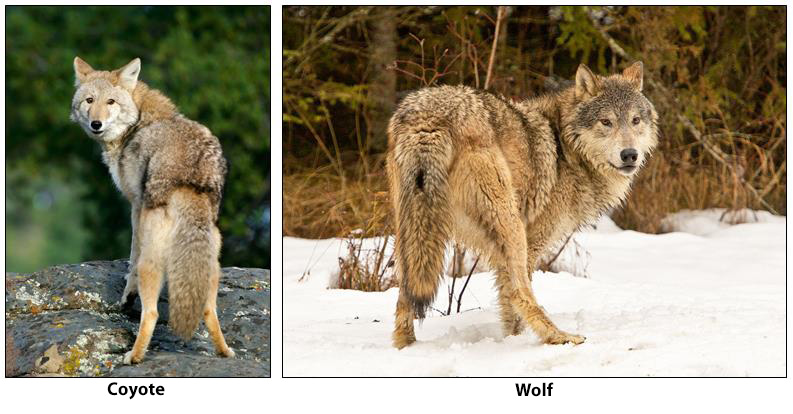
These two animals have similar coat colors, but different facial characteristics. The coyote on the left has a narrow snout and small nose pad, with large ears relative to its head size. The wolf on the right has a broad snout and large nose pad, with small ears relative to its head size. IMPORTANT: Wolf pups in mid-summer and fall can closely resemble coyotes, and it can be nearly impossible to tell them apart.
| COYOTE (Canis latrans) | GRAY WOLF (Canis lupus) | |
|---|---|---|
| Face | Narrow and pointed; small nose pad | Broad and blocky; large nose pad |
| Ears | Taller and pointed | Short and rounded |
| Shoulder Height | 21 – 24 inches | 26 – 32 inches |
| Length | 3.5 – 4.5 feet (nose to tail tip) | 4.5 – 6.5 feet (nose to tail tip) |
| Weight | 15-50 pounds | 70-150 pounds |
| Coat | Gray or reddish brown, often grizzled, often with whitish throat, chest, and/or belly | Grizzled gray is most common, but can also be mostly or all black; white or cream coats rare outside far northern populations |
Coyotes and Wolves by SOUND
COYOTE (Canis latrans)
- Voice typically higher pitched
- Howls shorter, rising and falling in pitch
- Usually interspersed with yips, yaps, and barks
GRAY WOLF (Canis lupus)
- Voice typically lower in pitch
- Howling tends to be long and drawn-out
- Can also include growls and barks
Coyotes and Wolves by SIGN
Tracks
COYOTE (Canis latrans)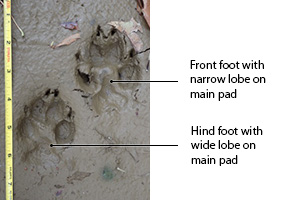
- 2.25 – 2.75 inches long, by 1.75 – 2.5 inches wide
- Crisp edges, especially in summer when less hair is present
- Long axes of the toes typically parallel
- Main pad of hind feet distinctly different than that of fore feet
- Claws of outer toes may not register
GRAY WOLF (Canis lupus)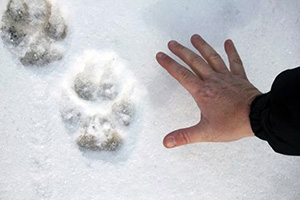
- 4 – 5.5 inches long, by 3.75 – 5 inches wide
- Very robust, especially in winter when extra hair is present between toes
- Inner toes appear bigger than in coyote tracks
- Outer toes, especially on fore feet, may tend to splay
- All four claws typically show in tracks
Scats
COYOTE (Canis latrans)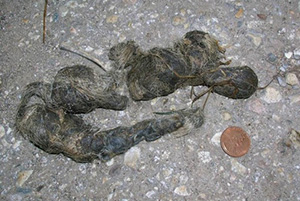
- Usually less than 1 inch in diameter
- May contain ungulate hair, but more typically contain hair and small bone fragments from rodents, rabbits
- Smoother, shinier appearance than wolf scat
- May taper to a point at one end
GRAY WOLF (Canis lupus)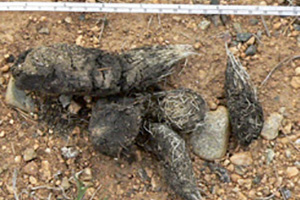
- Diameter ranges from .5 – 1.5 inches, but usually greater than 1 inch
- Often cord-like; may contain ungulate hair and bone fragments
- Generally taper to a point at one end
Dogs and Wolves
Distinguishing dogs from wolves can be challenging. Many of the traits possessed by wolves can also be found in domestic dogs, so no single trait should be used to definitively distinguish a dog from a wolf. When observing an animal, it is desirable to consider as many of the following traits as possible, including the animal’s behavior. Wild wolves will almost never approach a human.
Ears
DOG (Canis lupus familiaris)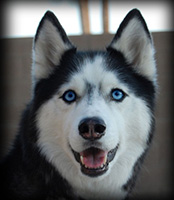
- Usually large relative to head size
- Often pointed tips
GRAY WOLF (Canis lupus)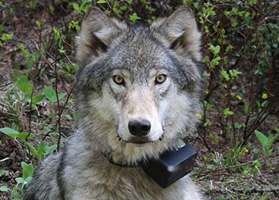
- Small relative to head size
- Tips more rounded
Tail
DOG (Canis lupus familiaris)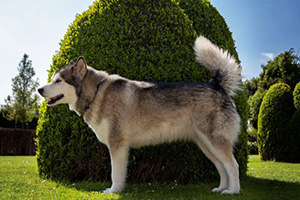
- May curl upward especially when running or trotting
- No scent gland spot
GRAY WOLF (Canis lupus)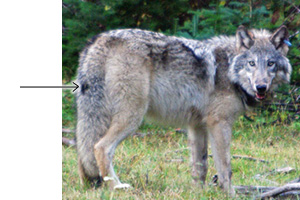
- Does not curl upward even when running
- Precaudal scent gland marked with dark hair (may not be visible in darker animals)
Chest
DOG (Canis lupus familiaris)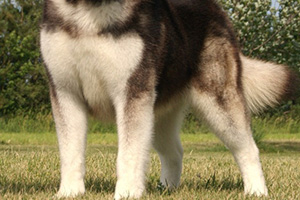
- Chest is broad so legs are separated
- Feet typically not splayed
GRAY WOLF (Canis lupus)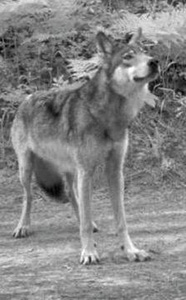
- Chest is very narrow so legs are close together
- Feet may splay outward
Eyes
DOG (Canis lupus familiaris)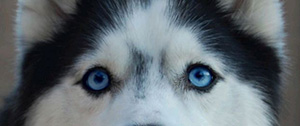
- Less slanted
- May be blue in color
GRAY WOLF (Canis lupus)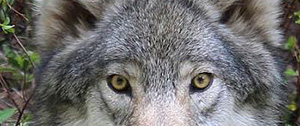
- Inner corners tend to slant downward
- Never blue in color
Scats
DOG (Canis lupus familiaris)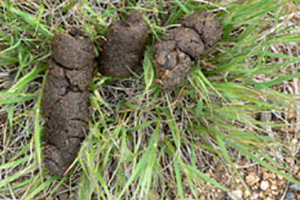
- Size can vary greatly
- Has a consistent appearance due to the consistency of commercial dog food
- Often lacks a tapered end
GRAY WOLF (Canis lupus)
- Diameter ranges from .5 – 1.5 inches, but usually greater than 1 inch
- Often cord-like; may contain ungulate hair and bone fragments
- Generally taper to a point at one end
Tracks
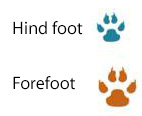
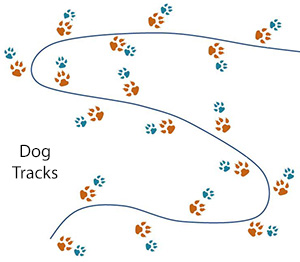
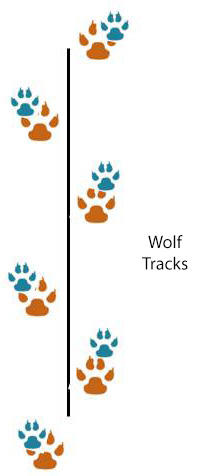
It can be impossible to distinguish a large dog from a wolf from a single track. Instead, if possible look for the pattern of the trail left by the animal. Dogs’ pattern of walking reflects their domestic lifestyle. They do not rely on stealth, and tend to walk erratically. Their hind foot tracks seldom register within their forefoot tracks. They may also approach strange objects directly. Wolves on the other hand, tend to walk more directly when travelling. Their trails reflect this, as the track of the hind foot is placed within or directly in front of the forefoot. Wolves will also approach strange objects cautiously, often circling widely to investigate rather than approaching directly.
Thanks to Adirondack Almanack; Alderleaf Wilderness College; California Wolf Center; Cook County Coyote Project; Andy Dobos – Three Red Trees School of Natural Living; Jim Halfpenny (A Field Guide to Mammal Tracking in North America); Internet Center for Wildlife Damage Management; Iron Pride Alaskan Malamutes; Oregon Dept. of Fish and Wildlife; Montana Fish, Wildlife and Parks; Richard Badger Photography; Western Wildlife Outreach; and Yamnuska Wolfdog Sanctuary for images and/or content.
